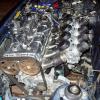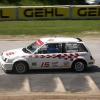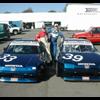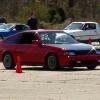Bob,
You're running 195/55-14's right? I ran the numbers and that extra inch in diameter makes a big difference compared to my old 185/60-13's. Its a 4mph difference at redline in 3rd. You are better off in your case with those tall tires in 3rd gear. You probably could do it in fourth but you have to nail the corner perfectly.

Lifting Rear Wheel Of Ground
Started by Kurt, Aug 11 2004 07:21 AM
46 replies to this topic
#31
 Posted 17 August 2004 - 12:33 PM
Posted 17 August 2004 - 12:33 PM

#32
 Posted 18 August 2004 - 07:20 AM
Posted 18 August 2004 - 07:20 AM

Greg, what is this spread sheet you have?
How do you take into consideration a 195/55 on a 14x5.5 vs say a 14x7? Or even a 195/55 from hoosier vs one kumho?
So many damn variables...
Glad to see racers here with all of this race talk. I LOVE IT!
How do you take into consideration a 195/55 on a 14x5.5 vs say a 14x7? Or even a 195/55 from hoosier vs one kumho?
So many damn variables...
Glad to see racers here with all of this race talk. I LOVE IT!
"If Honda does not race there is no Honda." -Soichiro Honda


#33
 Posted 18 August 2004 - 08:24 AM
Posted 18 August 2004 - 08:24 AM

The formula is:
MPH = (RPM * Tire Diameter) / (Gear Ratio * Final Drive * 336)
Note - Speed is in MPH, and Tire Diameter in inches (not wheel diameter). The '336' is the magical conversion factor that converts minutes to hours and inches to miles and somehow works Pi into the equation . You get the tire diameter from measuring it, or from the tire mfg data sheet. If you are running shaved tires, you'll need to measure them.
. You get the tire diameter from measuring it, or from the tire mfg data sheet. If you are running shaved tires, you'll need to measure them.
You Canadian dudes will have to modify or convert if you want to use it
I made a spread sheet in Excel that showed the speed in each gear in 200 RPM increments, using the above formula. I use a seperate column for each gear. This data is available in the shop manual that Tom has posted on line. (Unless you're Jay with his tricked out custom gear box with super close ratios )Change the tire diameter data or the final drive data and you can instantly see the change in speed. If you are familiar with Excel it shouldn't take more than 5 minutes to make a spreadsheet.
)Change the tire diameter data or the final drive data and you can instantly see the change in speed. If you are familiar with Excel it shouldn't take more than 5 minutes to make a spreadsheet.
Not all tires are the same diameter, and this does have a significant effect on overall gearing. Also, it shows you what your top speed really is since the speedometer will be off significantly when you go to shorter tires. Back when I ran IT on DOT tires I used to peg the speedo all the time at Road America but my true corrected speed was more like 105-108mph.
Edit to add note: I started my table at 4000rpm since I'm never below 4500 on the track....at least not intentionally
MPH = (RPM * Tire Diameter) / (Gear Ratio * Final Drive * 336)
Note - Speed is in MPH, and Tire Diameter in inches (not wheel diameter). The '336' is the magical conversion factor that converts minutes to hours and inches to miles and somehow works Pi into the equation
You Canadian dudes will have to modify or convert if you want to use it
I made a spread sheet in Excel that showed the speed in each gear in 200 RPM increments, using the above formula. I use a seperate column for each gear. This data is available in the shop manual that Tom has posted on line. (Unless you're Jay with his tricked out custom gear box with super close ratios
Not all tires are the same diameter, and this does have a significant effect on overall gearing. Also, it shows you what your top speed really is since the speedometer will be off significantly when you go to shorter tires. Back when I ran IT on DOT tires I used to peg the speedo all the time at Road America but my true corrected speed was more like 105-108mph.
Edit to add note: I started my table at 4000rpm since I'm never below 4500 on the track....at least not intentionally
Edited by Greg Gauper, 18 August 2004 - 08:27 AM.
2011 SCCA H-Production National Champion
#34
 Posted 18 August 2004 - 11:07 AM
Posted 18 August 2004 - 11:07 AM

QUOTE
(Unless you're Jay with his tricked out custom gear box with super close ratios  )
)
YEAH! AIN'T IT COOOL!
And another thing, who, in their right mind, would be looking at their speedometer when they're supposed to be racing?
I never could understand why some other guys would ask me what my speedo said when we ran at Daytona. (SSB days) I never looked at it! I was more interested in what RPM I was. Mainly because I knew the speedo was off and I knew that formula.
Jay
If you love the Elise, drive a Se7en - Caterham or whatever...
It has even less content than the Elise, is less graceful looking
...and changes direction like a ping pong ball whacked by Thor.

#35
 Posted 18 August 2004 - 11:48 AM
Posted 18 August 2004 - 11:48 AM

Greg,
Yes i'm running 195-55-14. I have not had time to plug in the numbers but, i trust you did and thats what you came up with. Sounds like i need to try it both ways at turn 1. I'm not racing until oct so i have time to sort it out. ALMS this weekend?
I'll be there on sun with Jim Dentici to pick up my ATV and watch the World Challenge race and the start of the ALMS race and then i'm off to home.
Bob
Yes i'm running 195-55-14. I have not had time to plug in the numbers but, i trust you did and thats what you came up with. Sounds like i need to try it both ways at turn 1. I'm not racing until oct so i have time to sort it out. ALMS this weekend?
I'll be there on sun with Jim Dentici to pick up my ATV and watch the World Challenge race and the start of the ALMS race and then i'm off to home.
Bob
#36
 Posted 18 August 2004 - 12:21 PM
Posted 18 August 2004 - 12:21 PM

lifting a while is a sign of chassis flex with high rear roll stiffness.
a stiffer chassis will reduce the lifting of the inner rear wheel (i understand that you will get some lift due to compression of the opposite front suspension). but if you have, say 8" of shock travel at the front left from totally topped out to totally bottomed out, and your right rear tire is 6" in the air, then a good portion of that 6" is chassis flex (maybe 1 or 2 inches?). especially with a high rear roll stiffness.
a car that is torsionally very rigid with enough rebound suspension travel (lifted wheel) should never lift a wheel off the ground.
my take is this:
if you are removing a tire from the surface, you are removing approximately 1/4 of your total contact patch., reducing total available grip.
a stiffer chassis will reduce the lifting of the inner rear wheel (i understand that you will get some lift due to compression of the opposite front suspension). but if you have, say 8" of shock travel at the front left from totally topped out to totally bottomed out, and your right rear tire is 6" in the air, then a good portion of that 6" is chassis flex (maybe 1 or 2 inches?). especially with a high rear roll stiffness.
a car that is torsionally very rigid with enough rebound suspension travel (lifted wheel) should never lift a wheel off the ground.
my take is this:
if you are removing a tire from the surface, you are removing approximately 1/4 of your total contact patch., reducing total available grip.
Edited by shadowboy, 18 August 2004 - 12:24 PM.
Shawn
--------
1987 CRX HF, black top D16A1 power.
Best ET so far: 15.130 @ 88.53mph
--------
1987 CRX HF, black top D16A1 power.
Best ET so far: 15.130 @ 88.53mph
#37
 Posted 18 August 2004 - 12:24 PM
Posted 18 August 2004 - 12:24 PM

QUOTE (Greg Gauper @ Aug 18 2004, 07:24 AM)
You Canadian dudes will have to modify or convert if you want to use it 
Not if you have one that calulates for both at the same time...
Kirk
#38
 Posted 18 August 2004 - 12:27 PM
Posted 18 August 2004 - 12:27 PM

QUOTE (shadowboy @ Aug 18 2004, 01:21 PM)
lifting a while is a sign of chassis flex with high rear roll stiffness.
a stiffer chassis will reduce the lifting of the inner rear wheel (i understand that you will get some lift due to compression of the opposite front suspension). but if you have, say 8" of shock travel at the front left from totally topped out to totally bottomed out, and your right rear tire is 6" in the air, then a good portion of that 6" is chassis flex (maybe 1 or 2 inches?). especially with a high rear roll stiffness.
a car that is torsionally very rigid with enough rebound suspension travel (lifted wheel) should never lift a wheel off the ground.
my take is this:
if you are removing a tire from the surface, you are removing approximately 1/4 of your total contact patch., reducing total available grip.
a stiffer chassis will reduce the lifting of the inner rear wheel (i understand that you will get some lift due to compression of the opposite front suspension). but if you have, say 8" of shock travel at the front left from totally topped out to totally bottomed out, and your right rear tire is 6" in the air, then a good portion of that 6" is chassis flex (maybe 1 or 2 inches?). especially with a high rear roll stiffness.
a car that is torsionally very rigid with enough rebound suspension travel (lifted wheel) should never lift a wheel off the ground.
my take is this:
if you are removing a tire from the surface, you are removing approximately 1/4 of your total contact patch., reducing total available grip.
i agree alot...but grip is also a function of weight. even if that wheel's on the ground. it isn't carrying any load.
Tony Palumbo
'86 CRX Si ZC
'86 CRX Si ZC
#39
 Posted 18 August 2004 - 01:10 PM
Posted 18 August 2004 - 01:10 PM

QUOTE (gtpilot @ Aug 18 2004, 12:24 PM)
QUOTE (Greg Gauper @ Aug 18 2004, 07:24 AM)
You Canadian dudes will have to modify or convert if you want to use it 
Not if you have one that calulates for both at the same time...
Kirk
One kicks Tom in the ass, 'cause the spreadsheet has been sitting in my inbox for months, waiting for me to do it...
"Toby, you are a thief of joy"
#40
 Posted 18 August 2004 - 01:16 PM
Posted 18 August 2004 - 01:16 PM

Not completely true.
Lifting an inside wheel has more to due with high rear roll stiffness and relatively lower front roll stiffness. Chassis flex has some effect but it is minimal.
Agreed that a wheel up in the air has no grip. Did you know that it is possible for a wheel to contact the ground and still have no grip? Several years ago I got to attend a seminar presented by Don Preston (chassis builder of several GT national champs) and William Mitchell, who sells a software package where you can see the dynamic loading on all four tires in all stages of cornering (straight line braking, trail braking to the apex, steady state cornering, corner exit acceleration, and full throttle straight line acceleration). He ran the simulator to show the typical loading on a tube-frame Trans-Am car. In some cases the modeling showed that the inside tires had virtually zero load on them even though the tires were still in contact with the ground.
Your comment that the wheel in the air reduces its available contact patch. I reply 'so what?' the car is already understeering and having more grip at the rear doesn't improve the situation.
The main thing a stiffer chassis does is make the car react to very small, subtle adjustments in a more predictable manner. Best demonstration of this is to look at old footage of pre-80 Nascars during pit stops. These had pretty flexible chassis' and you would see the crew make drastic changes during a pit stop i.e. several, several rounds of wedge, to compensate for changing track conditions. With todays significantly stiffer cars, you now see a crew make a very small subtle change like a half round change in wedge or track bar, 1/2 a psi in tire pressure, etc to compensate for changes in track condition.
The main benefit of a tube frame car like Kirk's compared to a tub car like mine or Jay's is that Kirk is allowed to to use 'real' racing suspension components and layout the geometry in a manner that is better capable of optimizing the available contact patch, where as Jay and I are limited by the rules of our class to do the best we can with the available geometry i.e. we can't relocate pick-up points, nor can we run heim joints in place of ball joints or tie-rods, etc. For the most part all we can do is change springs, T-bars, shocks, and sway bars. There is only so much you can do on a tub car to move weight around to get the best weight distrubution (both for and aft and side to side). A tube frame car is purpose built for racing in terms of geometry and weight distribution. For this reason, a tube frame GT car will typically be much flatter in the corners and will probably not lift a wheel compared to a tub car.
In my case it is also a case of compromise. I ran with no front sway bar last year and earlier in the year at Sebring. My car had quite a bit of front body roll but felt quite neutral even though it lifted a wheel. I made changes this spring to widen the track and go to wider, stickier tires and reconnected the front bar. While the car does corner flatter and doesn't lift the wheel as high, it doesn't feel as neutral as it did before. I would like to increase the rear roll stiffness with stiffer springs to regain some of the lost balance, but I am already over the spring rating for my shocks. I plan to get some better shocks that will once again allow me restore some of the balance, but that will have to wait until next year's budget. In the mean time I have to live with what I have which does have a higher overall cornering level compared to last years set up, but isn't as balanced as I would like.
Bob, I will be workng corners Sat & Sunday with the rest of the Milwaukee group. Ron Fellows is supposed to be driving the third Caddy in the GT class! Should be pretty cool. Also possible rain on Saturday. Should make the GT race really interesting! Endicott was turning 2:31's in Saturday's race in the Acura. I think pole will be in the high 2:29's if it is dry. BTW - Last year Pierre seemed to go pretty d*mned fast in his Real Time Acura with a wheel in the air........Imagine how fast he would be if the RTR guys didn't have their set up all wrong
Lifting an inside wheel has more to due with high rear roll stiffness and relatively lower front roll stiffness. Chassis flex has some effect but it is minimal.
Agreed that a wheel up in the air has no grip. Did you know that it is possible for a wheel to contact the ground and still have no grip? Several years ago I got to attend a seminar presented by Don Preston (chassis builder of several GT national champs) and William Mitchell, who sells a software package where you can see the dynamic loading on all four tires in all stages of cornering (straight line braking, trail braking to the apex, steady state cornering, corner exit acceleration, and full throttle straight line acceleration). He ran the simulator to show the typical loading on a tube-frame Trans-Am car. In some cases the modeling showed that the inside tires had virtually zero load on them even though the tires were still in contact with the ground.
Your comment that the wheel in the air reduces its available contact patch. I reply 'so what?' the car is already understeering and having more grip at the rear doesn't improve the situation.
The main thing a stiffer chassis does is make the car react to very small, subtle adjustments in a more predictable manner. Best demonstration of this is to look at old footage of pre-80 Nascars during pit stops. These had pretty flexible chassis' and you would see the crew make drastic changes during a pit stop i.e. several, several rounds of wedge, to compensate for changing track conditions. With todays significantly stiffer cars, you now see a crew make a very small subtle change like a half round change in wedge or track bar, 1/2 a psi in tire pressure, etc to compensate for changes in track condition.
The main benefit of a tube frame car like Kirk's compared to a tub car like mine or Jay's is that Kirk is allowed to to use 'real' racing suspension components and layout the geometry in a manner that is better capable of optimizing the available contact patch, where as Jay and I are limited by the rules of our class to do the best we can with the available geometry i.e. we can't relocate pick-up points, nor can we run heim joints in place of ball joints or tie-rods, etc. For the most part all we can do is change springs, T-bars, shocks, and sway bars. There is only so much you can do on a tub car to move weight around to get the best weight distrubution (both for and aft and side to side). A tube frame car is purpose built for racing in terms of geometry and weight distribution. For this reason, a tube frame GT car will typically be much flatter in the corners and will probably not lift a wheel compared to a tub car.
In my case it is also a case of compromise. I ran with no front sway bar last year and earlier in the year at Sebring. My car had quite a bit of front body roll but felt quite neutral even though it lifted a wheel. I made changes this spring to widen the track and go to wider, stickier tires and reconnected the front bar. While the car does corner flatter and doesn't lift the wheel as high, it doesn't feel as neutral as it did before. I would like to increase the rear roll stiffness with stiffer springs to regain some of the lost balance, but I am already over the spring rating for my shocks. I plan to get some better shocks that will once again allow me restore some of the balance, but that will have to wait until next year's budget. In the mean time I have to live with what I have which does have a higher overall cornering level compared to last years set up, but isn't as balanced as I would like.
Bob, I will be workng corners Sat & Sunday with the rest of the Milwaukee group. Ron Fellows is supposed to be driving the third Caddy in the GT class! Should be pretty cool. Also possible rain on Saturday. Should make the GT race really interesting! Endicott was turning 2:31's in Saturday's race in the Acura. I think pole will be in the high 2:29's if it is dry. BTW - Last year Pierre seemed to go pretty d*mned fast in his Real Time Acura with a wheel in the air........Imagine how fast he would be if the RTR guys didn't have their set up all wrong
Edited by Greg Gauper, 18 August 2004 - 01:45 PM.
2011 SCCA H-Production National Champion
#41
 Posted 18 August 2004 - 01:42 PM
Posted 18 August 2004 - 01:42 PM

I am going to disagree on the chassis flex theory. A limp noodle chassis isn't going to lift a wheel at all. In fact it will keep the wheel lower simply by the fact that it IS flexing.
The stiffer the chassis the higher the wheel.
Lets not confuse chassis with suspension! The stiffer the suspension on the front corners, the lower the oppisite rear corner will be. Ergo, if your front corners are stiffer (like installing 27 or 29mm TB's) your back end will lift only slightly off the ground.
The stiffer the suspension on the front corners, the lower the oppisite rear corner will be. Ergo, if your front corners are stiffer (like installing 27 or 29mm TB's) your back end will lift only slightly off the ground.
Having said that I am a total proponent of fwd lifting the inside rear tire off the ground ...if only slightly. Meaning that a well set up car should only lift the rear tire a few inches, not high enough to clear a cone!
Having the inside rear tire on the ground and sticking does nothing other than create push as you go around a corner.
And how did I learn all of this you ask? The hard way of course!

The stiffer the chassis the higher the wheel.
Lets not confuse chassis with suspension!
Having said that I am a total proponent of fwd lifting the inside rear tire off the ground ...if only slightly. Meaning that a well set up car should only lift the rear tire a few inches, not high enough to clear a cone!
Having the inside rear tire on the ground and sticking does nothing other than create push as you go around a corner.
And how did I learn all of this you ask? The hard way of course!
#42
 Posted 18 August 2004 - 03:43 PM
Posted 18 August 2004 - 03:43 PM

To dispell the chassis flex theory. EVERY front wheel drive British Touring Car lifts and inside rear wheel. And....I'm sure those cars have a VERY stiff chassis.
Not to mention most of the Speed World Challenge FWD cars also.
Not to mention most of the Speed World Challenge FWD cars also.
Must.....go......racing.......

#43
 Posted 18 August 2004 - 04:22 PM
Posted 18 August 2004 - 04:22 PM

QUOTE (RETROCRX @ Aug 18 2004, 02:43 PM)
To dispell the chassis flex theory. EVERY front wheel drive British Touring Car lifts and inside rear wheel. And....I'm sure those cars have a VERY stiff chassis.
Not to mention most of the Speed World Challenge FWD cars also.
Not to mention most of the Speed World Challenge FWD cars also.
My GT car lifts a wheel on occasion, I bet Jamie's does too (we'll find out in a few weeks...).
Kirk
#44
 Posted 18 August 2004 - 04:36 PM
Posted 18 August 2004 - 04:36 PM

Some very fast SWC cars lift a wheel:

Some fast British Touring cars do it as well:

Sometimes they lift more than one wheel!

Gee, those chassis look pretty stiff........
Tom, I would clean up the Ecel spread sheet so that it is only one sheet. This will make the file size smaller. I had a bunch of extra sheets for different combos. People can always copy and paste sheets to expand if they like.

Some fast British Touring cars do it as well:

Sometimes they lift more than one wheel!

Gee, those chassis look pretty stiff........
Tom, I would clean up the Ecel spread sheet so that it is only one sheet. This will make the file size smaller. I had a bunch of extra sheets for different combos. People can always copy and paste sheets to expand if they like.
Edited by Greg Gauper, 18 August 2004 - 04:39 PM.
2011 SCCA H-Production National Champion
#45
 Posted 18 August 2004 - 06:39 PM
Posted 18 August 2004 - 06:39 PM

 Sign In
Sign In Create Account
Create Account



 Back to top
Back to top
 View Garage
View Garage

















